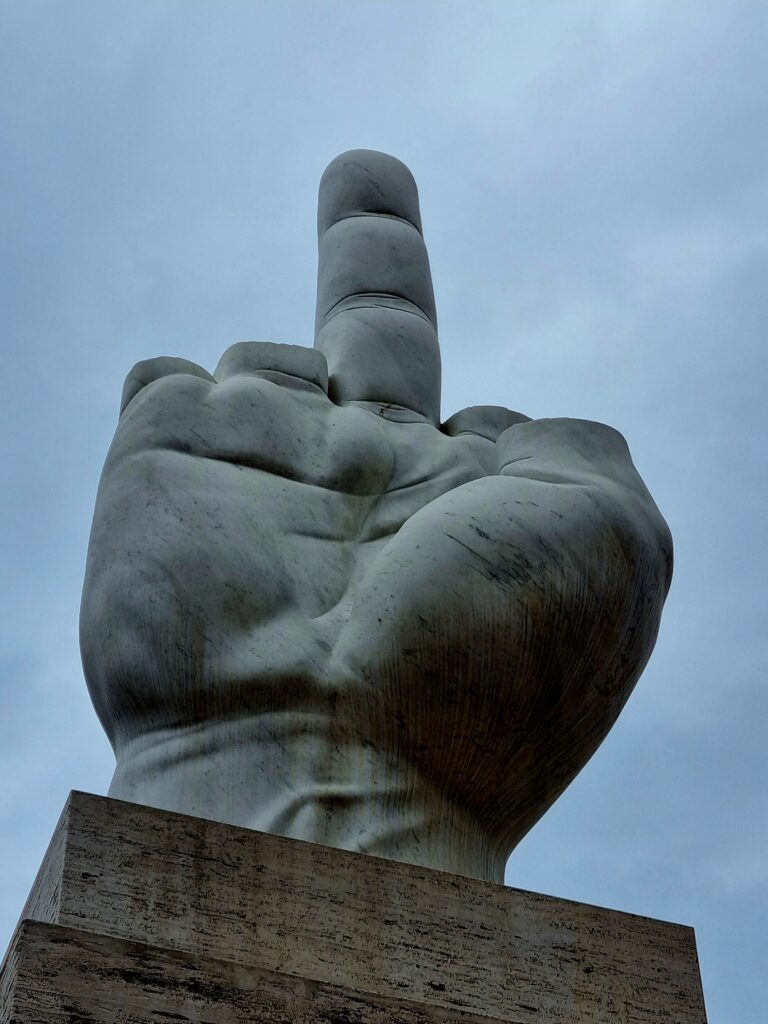Masterpiece Story: Portrait of Madeleine by Marie-Guillemine Benoist
What is the message behind Marie-Guillemine Benoist’s Portrait of Madeleine? The history and tradition behind this 1800 painting might explain...
Jimena Escoto 16 February 2025
In the heart of Milan, steps away from the iconic Duomo, Piazza Affari hosts a provocative sculpture by Maurizio Cattelan. Titled “L.O.V.E.” and commonly known as “The Finger,” this 11-meter-high marble middle finger faces the Stock Exchange headquarters, sparking diverse interpretations and reflections on ideologies, finance, and art. Read the story behind it!
Piazza Affari in Milan, Italy, hosts not only the Stock Exchange but also one of the most irreverent sculptures by the controversial artist Maurizio Cattelan. It is a 4.6-meter-high (11 meters including the pedestal) middle finger sculpted from precious Carrara marble. The finger is standing in front of Palazzo Mezzanotte, the headquarters of the Stock Exchange. This building is an architectural work from the 1930s, executed in the Novecento style and designed by architect Paolo Mezzanotte.

Maurizio Cattelan, L.O.V.E., 2010, Piazza Affari, Milan, Italy. Photo by the author.
Cattelan’s work does not stray far from the style of Palazzo Mezzanotte, as it is also executed in an unmistakable classical monumental style typical of the fascist era.
The sculpture is titled L.O.V.E., an acronym for Libertà (Freedom), Odio (Hate), Vendetta (Vengeance), and Eternità (Eternity). These words are often mentioned in propagandistic and extremist speeches. It is no coincidence that the work, installed in Piazza Affari in 2010, was inaugurated during the Palazzo Reale exhibition, Contro le Ideologie (Against Ideologies).

Maurizio Cattelan, L.O.V.E., 2010, Piazza Affari, Milan, Italy. Photo by the author.
Upon closer examination of the sculpture, it can be seen that what appears at first glance to be just a rude gesture is actually a hand with four fingers cut off or crumbled over time. The apparent intention of the hand was to make a Roman salute, a symbol of fascist ideology.

Maurizio Cattelan, L.O.V.E., 2010, Piazza Affari, Milan, Italy. Photo by the author.
The interpretive keys remain varied and never confirmed by the artist, known for being stingy with explanations and always happy to leave the viewer’s imagination free. One might think that the sculpture represents a clear insult to fascism and extremist ideologies in general. It serves as a reminder that, despite everything, art continues to fight and remains immune to the mechanisms of power and violence.
The sculpture’s placement in the square of the Stock Exchange also prompts reflection on the world of finance, banks, large capital, and, again, on a center of power that ultimately regulates our lives.
Cattelan’s finger, inaugurated a couple of years after the Lehman Brothers crash, stands against the economic mechanism of monetizing everything, including human beings, to make a profit.

Maurizio Cattelan, L.O.V.E., 2010, Piazza Affari, Milan, Italy. Photo by the author.
It is also true that the finger is not directed at the Stock Exchange but has its back to it. What if the great global market is looking down on us and mocking us? Reminding us that they have the power to build and dismantle entire worlds, and we, small in front of their finger, can only accept our fate.
Or maybe the artist simply wanted to make anyone who enters the square and sees it laugh. Whatever the interpretation, it remains a masterpiece of Cattelan’s genius, not only in its conception but especially in making us reflect on its many possible meanings, perhaps having none at all.
DailyArt Magazine needs your support. Every contribution, however big or small, is very valuable for our future. Thanks to it, we will be able to sustain and grow the Magazine. Thank you for your help!